With some NBFCs turning systemically significant over the years, owing to their size, complexity and interconnectedness, the RBI has sought to review their regulatory framework, adopting a scale-based approach.
Following its announcement in the December policy, the RBI has released a discussion paper on the revised regulatory framework for NBFCs, which proposes to bucket NBFCs into four layers --- Base Layer (NBFC-BL), Middle Layer (NBFC-ML), Upper Layer (NBFC-UL), and a possible Top Layer. Regulations around capital requirement, concentration norms, governance and disclosures have been proposed for each layer.
Here is all you need to know about the proposed framework.
How will NBFCs be bucketed into the four layers?
According to the RBI paper, the nature of activity will be the basis for determining the base and middle layer NBFCs. Hence, NBFC-BL will consist of NBFCs currently classified as non-systemically important NBFCs (NBFC-ND), besides Type I NBFCs (that do not have either access to public funds or customer interface), NBFC P2P (Peer to Peer), NOFHC (Non-Operative Financial Holding Company), and NBFC-AA (Account Aggregator). Given that these NBFCs are unlikely to pose any systemic risk on account of their activities, they can be regulated relatively lightly, according to RBI.
The Middle Layer (NBFC-ML) will consist of all non-deposit taking NBFCs classified currently as NBFC-ND-SI (292 as of July 2020) and all deposit taking NBFCs (64). This layer will exclude NBFCs which have been identified to be included in the Upper Layer. Further, NBFC-HFCs (housing finance company), IFCs (9 infrastructure finance companies), IDFs (4 infrastructure debt funds), SPDs (standalone primary dealers) and CICs (64 core investment companies), irrespective of their asset size, will fall in this bucket.
The upper layer ( top 50 NBFCs) will be determined based on a range of parameters --- size (35 per cent weight), inter-connectedness (25 per cent), complexity (10 per cent) and supervisory inputs (30 per cent, which includes type of liabilities, group structure and segment penetration). According to RBI, the top ten NBFCs (as per asset size) will automatically fall in this category (Bajaj Finance, LIC Housing Finance, etc.).
For now the top layer will remain empty. If there is a systemic risk perceived from specific NBFCs in the Upper Layer, the RBI can push some NBFCs into the top layer.
So what are the regulatory changes proposed for NBFCs under each of the three layers?
The proposed regulatory changes broadly pertain to capital, concentration norms and governance/ disclosure norms. For NBFCs in the base layer, regulations do not change significantly, but for the change in NPA classification to 90 days from 180 days currently. The asset size threshold has been raised to Rs 1,000 crore from Rs 500 crore, bringing more NBFCs under the base layer (9,209 from 9,133 earlier) and the entry norms have been tightened, raising the minimum net owned funds criteria to Rs 20 crore from Rs 2 crore earlier.
Certain governance changes have been proposed for the base layer, but the more significant changes have been proposed for entities falling in the middle and upper layer.
Do capital requirements go up significantly for NBFCs in the middle layer?
No, for NBFC-MLs, most of the changes proposed pertain to concentration and governance norms. Currently, NBFCs are required to maintain a minimum capital to risk weighted assets ratio (CRAR) of 15 per cent with minimum Tier I of 10 per cent. This will not change for middle layer NBFCs.
Currently, concentration norms for NBFCs are laid down separately for lending and investment exposures (15 per cent each for single borrower and 25 per cent for a group of borrowers). This is computed as a percentage of net owned funds. For NBFC-MLs, the RBI has proposed to merge the lending and investment limits into a single exposure limit of 25 per cent and group exposure of 40 per cent, computed as a per cent to Tier 1 capital (instead of net owned funds). This is not as stringent as for banks which currently have single and group exposure limits (as a per cent of Tier 1 capital) of 20 per cent and 25 per cent respectively.
Given that systemically important NBFCs already follow a 90-day NPA classification norm, there will be no impact on middle layer NBFCs. The standard asset provisioning of 0.4 per cent also remains unchanged.
Are there any other significant regulatory changes proposed for NBFC-MLs?
Yes. While the RBI has recognised the importance of providing ample flexibility in operations and not laid down hard core sector specific exposure limits, it has come down hard on IPO financing by proposing a Rs 1 crore per individual (per NBFC) ceiling. It has also laid down certain restrictions on lending --- buy-back of shares, loans to directors/their relatives, etc.
On the governance front, it has recommended constitution of remuneration committee, rotation of statutory auditors, and additional disclosures for mid-layer NBFCs.
How stringent are the norms for upper layer NBFCs? Are they on par with banks?
Yes, regulations will be more or less in line with that of banks. Given the scale of operations and the systemic significance, the RBI intends to tighten the norms for the top 25-30 NBFCs.
For instance, banks under the Basel III framework have to maintain a minimum Common Equity Tier 1 (CET 1) capital (of 7.375 per cent including capital conservation buffer). The RBI has proposed to introduce CET 1 for NBFC-UL, at 9 per cent. Similarly, NBFCs in the upper layer will also have to comply with the leverage requirement. Under Basel III, the leverage ratio is computed as capital (Tier I capital — numerator) divided by the bank’s exposures (denominator). Hence, a rise in exposure would lead to a fall in LR. The RBI has prescribed a minimum 3.5 per cent leverage ratio for banks (4 per cent for Domestic Systemically Important Banks) and proposes a suitable ceiling to be laid down for NBFC-ULs as well.
The top NBFCs will also move to differentiated standard provisioning norms (against the fixed 0.4 per cent), on par with banks. Hence NBFCs with higher exposure to say commercial real estate, may have to carry higher provisioning than earlier.
On the concentration norms, the RBI has proposed merging of lending and investment limits as in the case of mid-layer NBFCs, but closer to the existing banks’ limits with certain modifications.
While tightening governance and disclosure norms for NBFC-UL, the RBI also envisages mandatory listing for such NBFCs.









Comments
Comments have to be in English, and in full sentences. They cannot be abusive or personal. Please abide by our community guidelines for posting your comments.
We have migrated to a new commenting platform. If you are already a registered user of TheHindu Businessline and logged in, you may continue to engage with our articles. If you do not have an account please register and login to post comments. Users can access their older comments by logging into their accounts on Vuukle.